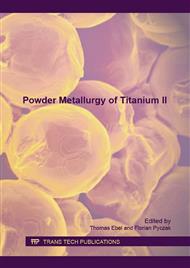[1]
D. F. Williams, On the mechanisms of biocompatibility, Biomaterials 29 (2008) 2941–2953.
Google Scholar
[2]
D. R. Sumner, J. O. Galante, Determinants of stress shielding: design versus materials versus interface, Clin. Orthop. Relat. Res. 274 (1992) 202–212.
DOI: 10.1097/00003086-199201000-00020
Google Scholar
[3]
Information on http: /www. njrcentre. org. uk.
Google Scholar
[4]
Y. Torres, J. J. Pavón, I. Nieto, J. A. Rodríguez, Conventional Powder Metallurgy Process and Characterization of Porous Titanium for Biomedical Applications, Metall and Materi Trans B 42 (2011) 891–900.
DOI: 10.1007/s11663-011-9521-6
Google Scholar
[5]
I. -H. Oh, N. Nomura, N. Masahashi, S. Hanada, Mechanical properties of porous titanium compacts prepared by powder sintering, Scripta Materialia 49 (2003) 1197–1202.
DOI: 10.1016/j.scriptamat.2003.08.018
Google Scholar
[6]
J. Parthasarathy, B. Starly, S. Raman, A. Christensen, Mechanical evaluation of porous titanium (Ti6Al4V) structures with electron beam melting (EBM), J Mech Behav Biomed Mater 3 (2010) 249–259.
DOI: 10.1016/j.jmbbm.2009.10.006
Google Scholar
[7]
J. P. Li, J. R. de Wijn, C. A. Van Blitterswijk, K. de Groot, Porous Ti6Al4V scaffold directly fabricating by rapid prototyping: Preparation and in vitro experiment, Biomaterials 27 (2006) 1223–1235.
DOI: 10.1016/j.biomaterials.2005.08.033
Google Scholar
[8]
C. E. Wen, M. Mabuchi, Y. Yamada, K. Shimojima, Y. Chino, T. Asahina, Processing of biocompatible porous Ti and Mg, Scripta Materialia 45 (2001) 1147–1153.
DOI: 10.1016/s1359-6462(01)01132-0
Google Scholar
[9]
V. Goriainov, R. Cook, J. M. Latham, D. G. Dunlop, R. O. C. Oreffo, Bone and metal: An orthopaedic perspective on osseointegration of metals, Acta Biomaterialia 10 (2014) 4043–4057.
DOI: 10.1016/j.actbio.2014.06.004
Google Scholar
[10]
A. R. Boccaccini, S. Keim, R. Ma, Y. Li, I. Zhitomirsky, Electrophoretic deposition of biomaterials, Journal of The Royal Society Interface 7 (2010) S581–S613.
DOI: 10.1098/rsif.2010.0156.focus
Google Scholar
[11]
L. L. Hench, Bioceramics: From Concept to Clinic, Journal of the American Ceramic Society 74 (1991) 1487–1510.
DOI: 10.1111/j.1151-2916.1991.tb07132.x
Google Scholar
[12]
Chen, Q., Cordero-Arias, L., Roether, J. A., Cabanas-Polo, S., Virtanen, S., Boccaccini, A. R., Alginate/Bioglass (R) composite coatings on stainless steel deposited by direct current and alternating current electrophoretic deposition. Surface and Coatings Technology 233 (2013).
DOI: 10.1016/j.surfcoat.2013.01.042
Google Scholar
[13]
F. Pishbin, A. Simchi, M. P. Ryan, A. R. Boccaccini, Electrophoretic deposition of chitosan/45S5 Bioglass® composite coatings for orthopaedic applications, Surface and Coatings Technology 205 (2011) 5260–5268.
DOI: 10.1016/j.surfcoat.2011.05.026
Google Scholar
[14]
T. Moskalewicz, S. Seuss, A. R. Boccaccini, Microstructure and properties of composite polyetheretherketone/Bioglass® coatings deposited on Ti–6Al–7Nb alloy for medical applications, Applied Surface Science 273 (2013) 62–67.
DOI: 10.1016/j.apsusc.2013.01.174
Google Scholar
[15]
Y. Torres, J. A. Rodríguez, S. Arias, M. Echeverry, S. Robledo, V. Amigo, J. J. Pavón, Processing, characterization and biological testing of porous titanium obtained by space-holder technique, Journal of Materials Science 47 (2012) 6565–6576.
DOI: 10.1007/s10853-012-6586-9
Google Scholar
[16]
ASTM F67-13, Standard Specification for Unalloyed Titanium, for Surgical Implant Applications (UNS R50250, UNS R50400, UNS R50550, UNS R50700), (2013) ASTM International.
DOI: 10.1520/f0067
Google Scholar
[17]
J. Currey, in: Black JH, Garth (eds), Handbook of Biomaterials Properties. Springer, London, (1998).
Google Scholar
[18]
J. Black, G. Hastings, Handbook of Biomaterials Properties, Chapman and Hall, London, (1998).
Google Scholar
[19]
G. Ryan, A. Pandit, and D.P. Apatsidis, Biomaterials 27 (13) (2006) 2651–2670.
Google Scholar
[20]
ASTM B962-15, Standard Test Methods for Density of Compacted or Sintered Powder Metallurgy (PM) Products Using Archimedes' Principle, (2015) ASTM International.
DOI: 10.1520/b0962-15
Google Scholar
[21]
ASTM E9-09, Standard Test Methods of Compression Testing of Metallic Materials at Room Temperature, (2009) ASTM International.
Google Scholar
[22]
T. Moskalewicz, S. Seuss & A.R. Boccaccini, Microstructure and properties of composite polyetheretherketone/Bioglass® coatings deposited on Ti–6Al–7Nb alloy for medical applications, Applied Surface Science 273 (2013) 62–67.
DOI: 10.1016/j.apsusc.2013.01.174
Google Scholar
[23]
ASTM C1624-05(2015), Standard Test Method for Adhesion Strength and Mechanical Failure Modes of Ceramic Coatings by Quantitative Single Point Scratch Testing, (2015) ASTM International.
DOI: 10.1520/c1624-05r15
Google Scholar
[24]
S. Borjas, E. J. Gil, L. Cordero, J.J. Pavón, J.A. Rodríguez, A.R. Boccaccini, Y. Torres, Electrophoretic Deposition and Characterization of Chitosan/45S5 Bioactive Glass Composite Coatings on Porous Titanium for Biomedical Applications, Key Engineering Materials 654 (2015).
DOI: 10.4028/www.scientific.net/kem.654.189
Google Scholar
[25]
A. C. Jones, C. H. Arns, D. W. Hutmacher, B. K. Milthorpe, A. P. Sheppard , M. A. Knackstedt, The correlation of pore morphology, interconnectivity and physical properties of 3D ceramic scaffolds with bone ingrowth, Biomaterials 30 (2009).
DOI: 10.1016/j.biomaterials.2008.10.056
Google Scholar
[26]
E. A. Vogler, Structure and reactivity of water at biomaterial surfaces, Advances in Colloid and Interface Science 74 (1998) 69-117.
DOI: 10.1016/s0001-8686(97)00040-7
Google Scholar
[27]
G. Welsch, R. Boyer, E. W. Collings, Materials Properties Handbook: Titanium Alloys. ASM International, (1993).
Google Scholar
[28]
J. R. Jones, Reprint of: Review of bioactive glass: From Hench to hybrids, Acta Biomaterialia 23 (2015) S53–S82.
DOI: 10.1016/j.actbio.2015.07.019
Google Scholar
[29]
S. Lopez-Esteban, E. Saiz, S. Fujino, T. Oku, K. Suganuma, A. P. Tomsia, Bioactive glass coatings for orthopedic metallic implants, Journal of the European Ceramic Society 23 (2003) 2921–2930.
DOI: 10.1016/s0955-2219(03)00303-0
Google Scholar
[30]
J. E. Mark, Physical Properties of Polymers Handbook, Springer New York, New York, (2007).
Google Scholar


